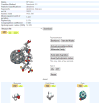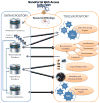Nanoinformatics knowledge infrastructures: bringing efficient information management to nanomedical research
- PMID: 24932210
- PMCID: PMC4053539
- DOI: 10.1088/1749-4699/6/1/014011
Nanoinformatics knowledge infrastructures: bringing efficient information management to nanomedical research
Abstract
Nanotechnology represents an area of particular promise and significant opportunity across multiple scientific disciplines. Ongoing nanotechnology research ranges from the characterization of nanoparticles and nanomaterials to the analysis and processing of experimental data seeking correlations between nanoparticles and their functionalities and side effects. Due to their special properties, nanoparticles are suitable for cellular-level diagnostics and therapy, offering numerous applications in medicine, e.g. development of biomedical devices, tissue repair, drug delivery systems and biosensors. In nanomedicine, recent studies are producing large amounts of structural and property data, highlighting the role for computational approaches in information management. While in vitro and in vivo assays are expensive, the cost of computing is falling. Furthermore, improvements in the accuracy of computational methods (e.g. data mining, knowledge discovery, modeling and simulation) have enabled effective tools to automate the extraction, management and storage of these vast data volumes. Since this information is widely distributed, one major issue is how to locate and access data where it resides (which also poses data-sharing limitations). The novel discipline of nanoinformatics addresses the information challenges related to nanotechnology research. In this paper, we summarize the needs and challenges in the field and present an overview of extant initiatives and efforts.
Figures







Similar articles
-
Nanoinformatics: emerging databases and available tools.Int J Mol Sci. 2014 Apr 25;15(5):7158-82. doi: 10.3390/ijms15057158. Int J Mol Sci. 2014. PMID: 24776761 Free PMC article. Review.
-
International efforts in nanoinformatics research applied to nanomedicine.Methods Inf Med. 2011;50(1):84-95. doi: 10.3414/ME10-02-0012. Epub 2010 Nov 18. Methods Inf Med. 2011. PMID: 21085742
-
European efforts in nanoinformatics research applied to nanomedicine.Stud Health Technol Inform. 2009;150:757-61. Stud Health Technol Inform. 2009. PMID: 19745412
-
Nanoinformatics for biomedicine: emerging approaches and applications.Int J Nanomedicine. 2013;8 Suppl 1(Suppl 1):1-5. doi: 10.2147/IJN.S41253. Epub 2013 Sep 16. Int J Nanomedicine. 2013. PMID: 24101873 Free PMC article.
-
Nanoinformatics and DNA-based computing: catalyzing nanomedicine.Pediatr Res. 2010 May;67(5):481-9. doi: 10.1203/PDR.0b013e3181d6245e. Pediatr Res. 2010. PMID: 20118825 Review.
Cited by
-
Nanocuration workflows: Establishing best practices for identifying, inputting, and sharing data to inform decisions on nanomaterials.Beilstein J Nanotechnol. 2015 Sep 4;6:1860-71. doi: 10.3762/bjnano.6.189. eCollection 2015. Beilstein J Nanotechnol. 2015. PMID: 26425437 Free PMC article.
-
Nanoinformatics: emerging databases and available tools.Int J Mol Sci. 2014 Apr 25;15(5):7158-82. doi: 10.3390/ijms15057158. Int J Mol Sci. 2014. PMID: 24776761 Free PMC article. Review.
-
Framework for automatic information extraction from research papers on nanocrystal devices.Beilstein J Nanotechnol. 2015 Sep 7;6:1872-82. doi: 10.3762/bjnano.6.190. eCollection 2015. Beilstein J Nanotechnol. 2015. PMID: 26665057 Free PMC article.
-
Using natural language processing techniques to inform research on nanotechnology.Beilstein J Nanotechnol. 2015 Jul 1;6:1439-49. doi: 10.3762/bjnano.6.149. eCollection 2015. Beilstein J Nanotechnol. 2015. PMID: 26199848 Free PMC article. Review.
-
A machine learning approach to identify clinical trials involving nanodrugs and nanodevices from ClinicalTrials.gov.PLoS One. 2014 Oct 27;9(10):e110331. doi: 10.1371/journal.pone.0110331. eCollection 2014. PLoS One. 2014. PMID: 25347075 Free PMC article.
References
-
- Baker NA, Fritts M, Guccione S, Paik DS, Pappu RV, Patri A, Rubin D, Shaw SY, Thomas DG. Nanotechnology Informatics White Paper. National Cancer Institute; 2009. caBIG. February 2009. Non-peer Reviewed Manuscript.
-
- Bellare JR. Nanotechnology and nanomedicine for healthcare: challenges in translating innovations from bench to bedside. J Biomed Nanotechnol. 2011;7:36–7. - PubMed
Grants and funding
LinkOut - more resources
Full Text Sources
Other Literature Sources
